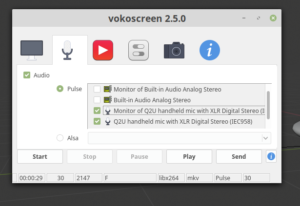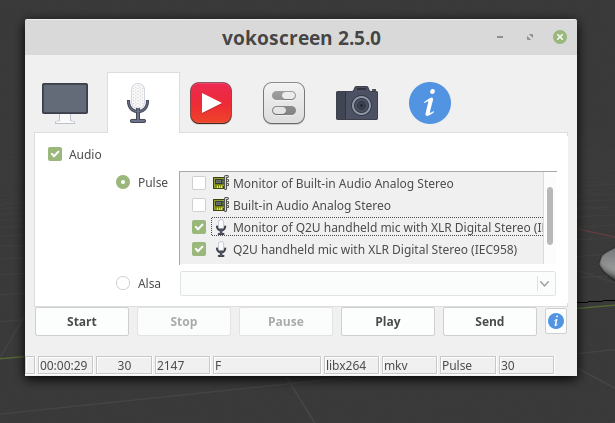Author: Waylena
Planetarium professional since 1992. User of Free and Open Source Software since 2001.
vokoscreen
How am I only now learning of vokoscreen?
 |
| vokoscreen is simple and straightforward |
I’ve been a fan of OBS studio and it still is pretty amazing, but with my new microphone, a Samson Q2U USB, it is giving me headaches on my Linux laptop. It will not consistently keep settings to record video from builtin webcam and the audio from ONLY the usb mic.
I can use SimpleScreenRecorder or recrodMyDesktop if I don’t need to occasionally have the webcam video added. Both of those work extremely well.
But of course I want it all, and wherever possible I want it open source. I’m working on some video walk-throughs of interesting blend files I’ve made to help teach others who might be interested. And being able to record with the least hassle is extremely important.
It seems to be Linux-only which is sad, and I don’t even think it’s being developed any more. But for now, vokoscreen is just what I need.
 |
| Happy Waylena is happy. |
Free SVG
With openclipart.org forever gone, I’m always on the lookout for sources of free vector graphics.
I have found publicdomainvectors.org to be useful. The admins of that site have now created a site closer to the spirit of the old openclipart.org site: freesvg.org
ShareTextures
As seen on BlenderNation…
ShareTextures hosts a variety of textures. Created primarily for architectural visualizations, the textures are CC0.
Rotating Earth / Spinning Top
I shared this previously on Facebook, but I’m back to the project.
The blend file is available here:
https://github.com/waystar/Sample-Blend-Files
Drop me a line if you want the PNG frames with alpha background.
Nodevember!
I might try some of these, since I want to step up my node-based procedural textures game!
 |
| From nodevember.io |
I won’t have time to do them all, but I’ll try to some of them. I will of course be using Blender, but any procedural/node based software can be used.
Fulldome Blender 2.8 Workshop GLPA 2019
The 2019 annual meeting of the Great Lakes Planetarium Association was held last week, hosted by the Ritter Planetarium of The University of Toledo.
It was special for me because my planetarium career started at Ritter Planetarium in February 1992. Honestly I had planned to stop conducting workshops for a few years so that I could concentrate on my GLPA executive community duties. But Alex Mak asked so of course I said yes.
The result is a very revised version *NEW!* for Blender 2.8:
https://github.com/waystar/2019-Blender-Workshop-Materials
- Setting up render engine, camera and outputs for fulldome masters.
- Setting up layers to separate objects for compositing to get glows or denoising only on some objects.
- Compositing node setups examples.
- Basics of materials, with shader node tree examples for incorporating alpha channels and animating fades between textures.
- World environment settings and node trees for animation.
- Examples of animating various objects and effects achieved through animating modifiers.
https://github.com/waystar/2019-Blender-Workshop-Materials
Click the “Clone or download” button to download the whole thing in a zip file.
Drop me a line if you find mistakes or OS-related differences. (I test on Linux and Windows.) Also, let me know if you find any of it particularly useful and I would LOVE to see what you make.
And of course, if you are having trouble with something in particular that you are trying to do, let me know. If I can’t help get it to work, I might be able to suggest alternate approaches to get the same effect.
Vahana VR & VideoStitch Studio
Vahana VR & VideoStitch Studio: software to create immersive 360° VR video, live and in post-production.
I ran across this by accident today. I don’t yet have a dual camera setup to work with, but I want to be prepared. I ran across a discussion thread talking about the software and then the thread turned to sadness with a post that the company making it had folded. Then at the end was another post linking to another thread cheering the revival of the software as an open source project with the MIT License.
https://github.com/stitchEm/stitchEm
Honestly it has been a few years since I’ve built my own packages. Hopefully I can satisfy the dependencies through package managers at least. (If I had time to compile everything, I would still be running Gentoo. It ran mighty fast, but compiling time added up.)
If and when I manage to trying it out, I will be sure to update.
Update on class: 3D Data Visualization for Science Communication
I am still here, I promise! Been away from work and prepping for the upcoming GLPA conference.
In the midst of all that, I’ve been taking the Coursera class mentioned last month. Although the instructors emphasize Houdini because that’s what they use for cinematic rendering, they do mentioned Blender frequently. I have installed the apprentice version of Houdini (yay for Linux version!) but haven’t had time to learn it. Thus I am doing the assignments in Blender.
Solar System render from specific assignment parameters using textures provided.
The instructors are doing a great job of breaking down concepts and using those concepts as they explain how and why they decide on approaches to their work. The quizzes are challenging and thought provoking.
In my own work, I mostly create science illustrations rather than visualizations. Even so, I find myself putting more focused thought into my work now. And I like that. I like that a lot.
3D Data Visualization for Science Communication class on Coursera
It’s not solely FOSS stuff, but I’m taking this course:




